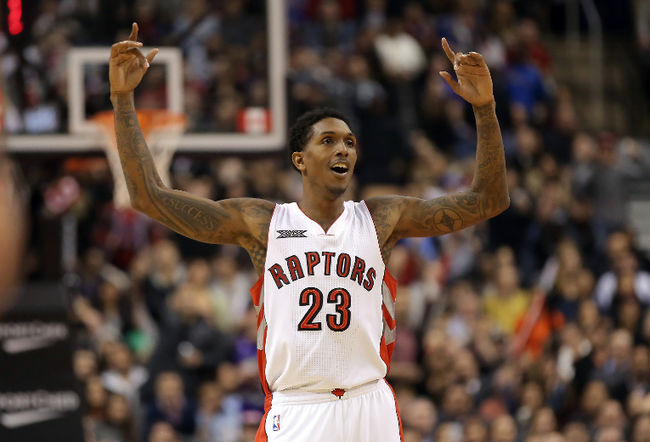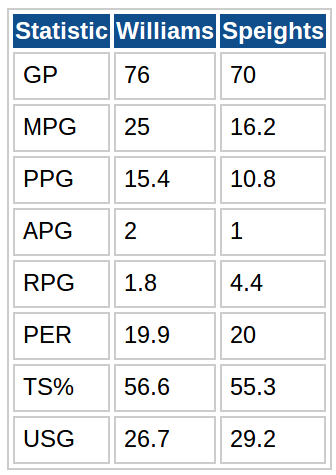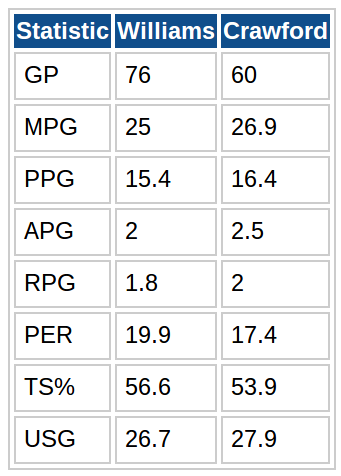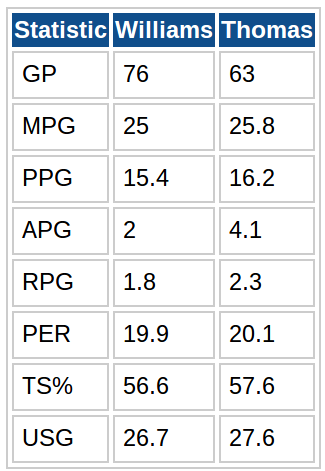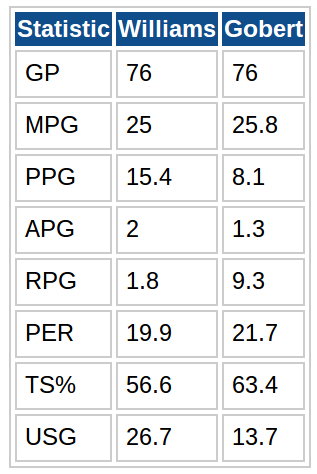Booming out in South Gwinnett like I’m Lou Will.
In a season filled with dashed expectations, the play of Lou Williams has been a pleasant surprise for the Toronto Raptors.
No one expected this type of production from Williams, especially after having two sub-par, injury-riddled seasons with the Atlanta Hawks. The price he went for (John Salmons’s expiring deal) also didn’t inspire confidence. The Hawks even had to throw in their 2013 lottery pick in Bebe Nogueira to offload Williams.
No one was expecting this bounce-back campaign from Williams. After a string of injury-shortened seasons, Williams has appeared in all but one game for the Raptors, posting averages of 15.4 points, 1.8 rebounds and two assists in 25 minutes per game. Those numbers are even more impressive in the context of his underlying advanced statistics. His true-shooting percentage of 56.6 percent is the highest out of any Raptor with a usage of over 20 percent and the vast majority of his shots are unassisted. In true gunner fashion, Williams has created his own offense and has done it better than almost every other Raptor this season.
Williams has captained a surprisingly resurgent bench unit. The five-man lineup of Williams, Greivis Vasquez, James Johnson, Patrick Patterson and Tyler Hansbrough has been fantastic, outscoring opponents by 19.9 points per 100 possessions. Williams leads the way with the best net rating out of the group at +7.6 (min: 1000 played). That mark also tops the team. Granted, the bench’s success isn’t all Williams’s doing, but he is the unquestioned leader on offense for the second unit.
Defensively, Williams does have some issues. He’s not the most persistent defender and will usually fall behind the play if he is asked to navigate through screens. Williams is also too slight to guard any position other than point guard, which has forced Dwane Casey into making some sacrifices in order to play his best three-man backcourt combination of Williams, Kyle Lowry and DeMar DeRozan. However, it should be noted that the Raptors’ perimeter defense, as a collective, has been unfathomably terrible, which suggests a potential flaw in the defensive system (hint: it is).
But while Williams’s case for Sixth Man is impressive, he does have more than a few contenders for the bench crown. Here’s how Williams fares against his competition.
Competitor: Nikola Mirotic
On the surface, Mirotic’s numbers don’t hold a candle to Williams’s production. But after catching fire for all of March as the Bulls’ number one option, there’s a real case to be made for the Montenegrin gunner. Mirotic averaged 20.8 points and 7.6 rebounds per game in March and twice burned the Raptors during that time, going off for 29 and 15 respectively.
Mirotic brings more than raw scoring to the table. He’s also a quick and crafty defender, able to guard both threes and fours, and the Bulls’ defense has actually been better with Mirotic on the court. He’s also brings floor stretch at the forward spot, a skill no other Bulls big possesses. Combined with a lethal dribble-drive game, Mirotic has proven to be a tremendously frustrating cover.
However, despite his recent outburst, it’s hard to overlook Mirotic’s rough start. Between October and February, Mirotic averaged just 7.2 points and 4.3 rebounds on 39.4 percent shooting in limited minutes off the bench. For that, Mirotic falls behind Williams’s year-long consistency.
Competitor: Marreese Speights
It’s safe to say that Speights woke up in a new Mo Gotti (sorry), because the sweet-stroking forward has posted career-highs across the board as part of the historically-dominant Golden State Warriors. He’s only logged 16.2 per game, but he’s been tremendous when he’s played, posting per-36 averages of 24 points and 9.7 rebounds on a true-shooting percentage of 55.3 percent.
Speights is a dead-eye shooter from the mid-range. He knocks down 44.6 percent of his looks in the midrange area, a mark on-par with LaMarcus Aldridge (41.9 percent). He gives the Warriors a trusty release valve option in the odd broken possession and he’s a passable defender at the five.
But while Speights has been tremendous in limited minutes, there is something to be said about volume of production. Obviously, it’s not Speights’s fault that he has two tremendous frontcourt players in Draymond Green and Andrew Bogut in front of him, but in 32 years of the award’s existence, there has only ever been one player (Bill Walton on Larry Bird’s 1985-86 Celtics) has won the award while playing less than 20 minutes per game. And while the Warriors, like the glory-day Celtics, are historically dominant, Speights is a long way from Walton. For that, Williams gets the nod.
It should be also be noted that the Warriors have multiple potential Sixth Man candidates. Andre Iguodala, Shaun Livingston and even Festus Ezeli have been great bench producers.
Competitor: Jamal Crawford
Year after year, Crawford ends up on this list. He’s basically a carbon-copy of Williams, only taller and flashier. In his 15th (!!) season, the 35-year-old Crawford has remained excellent, helping prop up a downright horrible bench for the Clippers.
Both Crawford and Williams are equally poor defenders and they play the exact same role, so a comparison of their numbers is appropriate. The only appreciable difference between the two is how often Crawford is assisted on his 3-pointers (75 percent to 55 percent) which makes Williams’s production slightly more impressive. But then again, Crawford plays in the West. In a head-to-head comparison, Crawford has the edge in raw points per game, but Williams leads on a per-36 basis. Williams shoots more free throws and grabs more steals, while Crawford dishes out more assists. The only notable difference is PER, where Williams has him beat. But for the most part, their seasons are virtually indistinguishable.
Ultimately, it comes down to injuries. Williams has stayed healthy all year long, whereas Crawford has been out since the start of March with a calf injury. For that, Williams, again, gets the nod.
Competitor: Isaiah Thomas
The case for IT2 is tricky. On one hand, he’s been an absolute monster since moving over to Boston (we saw that first-hand on Saturday). On the other, it looked like the Phoenix Suns and Sacramento Kings couldn’t wait to dump him. Thomas seems to be a nice guy and there aren’t any concrete reports of any personality clashes, but it’s curious that a reasonably-priced player would be so consistently undervalued.
But regardless, this much is clear about Thomas: he can score and he can create for others.
Thomas narrowly edges out Williams in scoring and is almost doubling Williams’s assist totals. Moreover, Thomas has remained productive across two teams in two conferences, which takes any system effects out of the equation (the Suns’ five-out attack is conducive to guard play). Thomas even has Williams beat in true-shooting percentage, making him the slightly more effective scorer.
However, it circles back to games played. Thomas has only appeared in 63 games this season as compared to 76 for Williams. For that, Williams edges out Thomas. Otherwise it would be awfully close.
Competitor: Rudy Gobert
Technically speaking, Gobert qualifies for the Sixth Man award despite serving as the Jazz’s starter for 31 games. The key there is that Gobert has to come off the bench for more than half of his games played, which he has done.
The emergence of Gobert has taken the league by storm. The 22-year-old Frenchman boasts the longest wingspan ever recorded at the draft (shoutout to Blake Murphy for that knowledge nugget) and has anchored the league’s best defense since he was permanently instilled as the starter following the Enes Kanter trade. And it hasn’t even been close. By defensive rating, the difference between the Jazz’s top-rated defense and Warriors’s second-ranked defense is the same as that of the Warriors to a middle-of-the-pack defense.
Billing Gobert as another DeAndre Jordan-lite would be disingenuous, because he’s even better than Jordan in many respects. Gobert is blocking more shots per game despite playing 10 minutes less per game than Jordan and he’s a much better free-throw shooter. Jordan is definitely the better rebounder and he’s anchored a playoff team in the Clippers, but the Jazz’s defense has actually been much better than the Clippers’s and much of that relates back to Gobert’s presence. Opponents are shooting just 39 percent at the rim when Gobert is around, a mark that leads the league (min: 5 FGA at rim per game).
It has to be noted that Gobert is limited offensively. The Jazz are 6.3 points per 100 possessions worse offensively with Gobert on the court. There’s no getting around the fact that Gobert’s offense is limited to mostly putbacks and pick-and-roll finishes. But at least he’s done so at an incredibly efficient rate.
Altogether, despite the weaker offensive production and flimsy technicality of Gobert’s qualifications for “Sixth Man”, his defensive impact is too great to ignore. For that, Gobert gets the edge over Williams, who finishes second in my imaginary ballot. Sorry, namesake guard.
Statistics accurate (hopefully) through Saturday, April 4.

